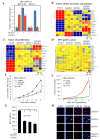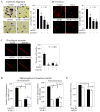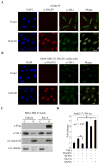Cell fate factor DACH1 represses YB-1-mediated oncogenic transcription and translation
- PMID: 24335958
- PMCID: PMC3933065
- DOI: 10.1158/0008-5472.CAN-13-2466
Cell fate factor DACH1 represses YB-1-mediated oncogenic transcription and translation
Abstract
The epithelial-mesenchymal transition (EMT) enhances cellular invasiveness and confers tumor cells with cancer stem cell-like characteristics, through transcriptional and translational mechanisms. The mechanisms maintaining transcriptional and translational repression of EMT and cellular invasion are poorly understood. Herein, the cell fate determination factor Dachshund (DACH1), suppressed EMT via repression of cytoplasmic translational induction of Snail by inactivating the Y box-binding protein (YB-1). In the nucleus, DACH1 antagonized YB-1-mediated oncogenic transcriptional modules governing cell invasion. DACH1 blocked YB-1-induced mammary tumor growth and EMT in mice. In basal-like breast cancer, the reduced expression of DACH1 and increased YB-1 correlated with poor metastasis-free survival. The loss of DACH1 suppression of both cytoplasmic translational and nuclear transcriptional events governing EMT and tumor invasion may contribute to poor prognosis in basal-like forms of breast cancer, a relatively aggressive disease subtype.
Conflict of interest statement
Conflicts of Interest: R.G.P. holds major (> $10,000) ownership interests in, and serves as CSO/Founder of the biopharmaceutical companies ProstaGene, LLC and AAA Phoenix, Inc. R.G.P. additionally holds ownership interests (value unknown) for several submitted patent applications.
Figures






Similar articles
-
DACH1 suppresses breast cancer as a negative regulator of CD44.Sci Rep. 2017 Jun 28;7(1):4361. doi: 10.1038/s41598-017-04709-2. Sci Rep. 2017. PMID: 28659634 Free PMC article.
-
Cell fate determination factor Dachshund reprograms breast cancer stem cell function.J Biol Chem. 2011 Jan 21;286(3):2132-42. doi: 10.1074/jbc.M110.148395. Epub 2010 Oct 11. J Biol Chem. 2011. PMID: 20937839 Free PMC article.
-
BRD7 suppresses invasion and metastasis in breast cancer by negatively regulating YB1-induced epithelial-mesenchymal transition.J Exp Clin Cancer Res. 2020 Feb 7;39(1):30. doi: 10.1186/s13046-019-1493-4. J Exp Clin Cancer Res. 2020. PMID: 32028981 Free PMC article.
-
The Dachshund gene in development and hormone-responsive tumorigenesis.Trends Endocrinol Metab. 2010 Jan;21(1):41-9. doi: 10.1016/j.tem.2009.08.002. Epub 2009 Nov 5. Trends Endocrinol Metab. 2010. PMID: 19896866 Free PMC article. Review.
-
YB-1 Protein in Breast Cancer (Scientific and Personal Meetings with Professor Ovchinnikov).Biochemistry (Mosc). 2022 Jan;87(Suppl 1):S86-S47. doi: 10.1134/S0006297922140073. Biochemistry (Mosc). 2022. PMID: 35501988 Review.
Cited by
-
Upregulated PARP1 confers breast cancer resistance to CDK4/6 inhibitors via YB-1 phosphorylation.Exp Hematol Oncol. 2023 Nov 30;12(1):100. doi: 10.1186/s40164-023-00462-7. Exp Hematol Oncol. 2023. PMID: 38037159 Free PMC article.
-
SIX1 Predicts Poor Prognosis and Facilitates the Progression of Non-small Lung Cancer via Activating the Notch Signaling Pathway.J Cancer. 2022 Jan 1;13(2):527-540. doi: 10.7150/jca.61385. eCollection 2022. J Cancer. 2022. PMID: 35069900 Free PMC article.
-
YB-1 interplays with ERα to regulate the stemness and differentiation of ER-positive breast cancer stem cells.Theranostics. 2020 Feb 19;10(8):3816-3832. doi: 10.7150/thno.41014. eCollection 2020. Theranostics. 2020. PMID: 32206124 Free PMC article.
-
Crosstalk between Akt signaling and cold shock proteins in mediating invasive cell phenotypes.Oncotarget. 2018 Apr 10;9(27):19039-19049. doi: 10.18632/oncotarget.24886. eCollection 2018 Apr 10. Oncotarget. 2018. PMID: 29721182 Free PMC article.
-
The WAVE3-YB1 interaction regulates cancer stem cells activity in breast cancer.Oncotarget. 2017 Oct 24;8(61):104072-104089. doi: 10.18632/oncotarget.22009. eCollection 2017 Nov 28. Oncotarget. 2017. PMID: 29262622 Free PMC article.
References
-
- Polyak K, Weinberg RA. Transitions between epithelial and mesenchymal states: acquisition of malignant and stem cell traits. Nat Rev Cancer. 2009:265–273. - PubMed
-
- Fu M, Wang C, Reutens AT, Wang J, Angeletti RH, Siconolfi-Baez L, et al. p300 and p300/cAMP-response element-binding protein-associated factor acetylate the androgen receptor at sites governing hormone-dependent transactivation. J Biol Chem. 2000:20853–20860. - PubMed
Publication types
MeSH terms
Substances
Grants and funding
LinkOut - more resources
Full Text Sources
Other Literature Sources
Medical
Molecular Biology Databases
Research Materials

